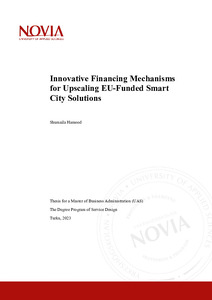Innovative Financing Mechanisms for Upscaling EU-Funded Smart City Solutions
Hamood, Shumaila (2023)
Hamood, Shumaila
2023
Julkaisun pysyvä osoite on
https://urn.fi/URN:NBN:fi:amk-2023121135837
https://urn.fi/URN:NBN:fi:amk-2023121135837
Tiivistelmä
Positive energy districts, which produce more energy than they consume, are envisioned to be deployed across Europe by the European Commission by 2050. RESPONSE is one such project, a 60-month implementation plan under the Horizon 2020 funding program of the European Commission. By integrating energy-efficient heating and cooling systems, lighting solutions, smart mobility, and sustainable retrofits into existing building clusters, the project's primary objective is to establish positive energy districts.
As one of the lighthouse cities of RESPONSE, the city of Turku along with its partner organizations in the project, is actively exploring funding options to identify liquidity and investment partners. They will also lay out how to combine the available funding options of the EU Commission with new financing mechanisms to upscale the project and look for replication opportunities.
The already developed business model used in RESPONSE was examined in this thesis study to identify strengths, limitations, and areas for improvement. The emphasis was on overcoming barriers and risks to ensure the effective implementation of the business model and identify new revenue sources. Experts' opinions were considered to promote replication in other areas by identifying and addressing risk factors.
In this study, the research methodologies used to collect data were a blend of preparatory research, e-research, conversation and discourse analysis, participant observation, qualitative comparative analysis, and building a research wall to apprehend the complications and derive solutions. Additionally, tools like benchmarking and case study analysis were used. A co-creative workshop method was also used to build system mapping. A stakeholder map and service blueprint were generated during system mapping to gain profound knowledge of the research study.
In conclusion, all the research methods and tools employed to collect information were utilized to create a toolkit that culminated as a decision matrix for selecting appropriate financing options for implementing any given integrated solution as an upscaling or replication of the project.
In addition, the use case analysis of 5G lighting poles and Direct current–coupled bi-facial solar panel systems were discussed to understand the dynamics of the business model and how financing mechanisms can be introduced for the particular integrated solutions.
As one of the lighthouse cities of RESPONSE, the city of Turku along with its partner organizations in the project, is actively exploring funding options to identify liquidity and investment partners. They will also lay out how to combine the available funding options of the EU Commission with new financing mechanisms to upscale the project and look for replication opportunities.
The already developed business model used in RESPONSE was examined in this thesis study to identify strengths, limitations, and areas for improvement. The emphasis was on overcoming barriers and risks to ensure the effective implementation of the business model and identify new revenue sources. Experts' opinions were considered to promote replication in other areas by identifying and addressing risk factors.
In this study, the research methodologies used to collect data were a blend of preparatory research, e-research, conversation and discourse analysis, participant observation, qualitative comparative analysis, and building a research wall to apprehend the complications and derive solutions. Additionally, tools like benchmarking and case study analysis were used. A co-creative workshop method was also used to build system mapping. A stakeholder map and service blueprint were generated during system mapping to gain profound knowledge of the research study.
In conclusion, all the research methods and tools employed to collect information were utilized to create a toolkit that culminated as a decision matrix for selecting appropriate financing options for implementing any given integrated solution as an upscaling or replication of the project.
In addition, the use case analysis of 5G lighting poles and Direct current–coupled bi-facial solar panel systems were discussed to understand the dynamics of the business model and how financing mechanisms can be introduced for the particular integrated solutions.
